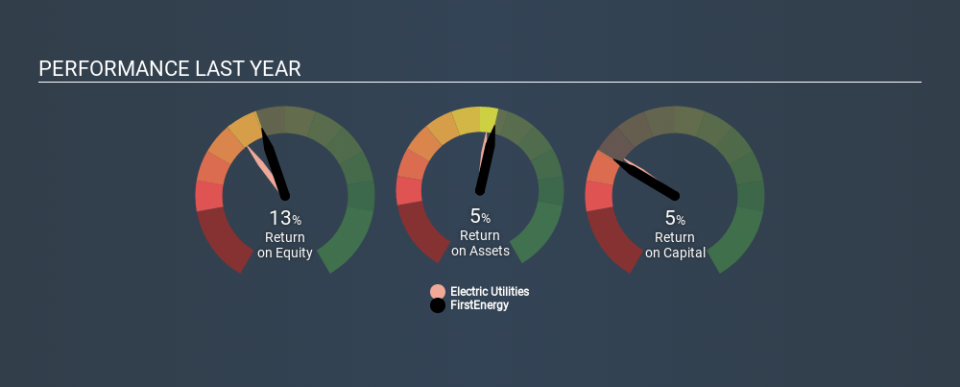Is FirstEnergy Corp. (NYSE:FE) Investing Effectively In Its Business?

Today we'll look at FirstEnergy Corp. (NYSE:FE) and reflect on its potential as an investment. To be precise, we'll consider its Return On Capital Employed (ROCE), as that will inform our view of the quality of the business.
Firstly, we'll go over how we calculate ROCE. Then we'll compare its ROCE to similar companies. Last but not least, we'll look at what impact its current liabilities have on its ROCE.
What is Return On Capital Employed (ROCE)?
ROCE is a metric for evaluating how much pre-tax income (in percentage terms) a company earns on the capital invested in its business. Generally speaking a higher ROCE is better. Overall, it is a valuable metric that has its flaws. Renowned investment researcher Michael Mauboussin has suggested that a high ROCE can indicate that 'one dollar invested in the company generates value of more than one dollar'.
So, How Do We Calculate ROCE?
Analysts use this formula to calculate return on capital employed:
Return on Capital Employed = Earnings Before Interest and Tax (EBIT) ÷ (Total Assets - Current Liabilities)
Or for FirstEnergy:
0.049 = US$1.8b ÷ (US$42b - US$4.9b) (Based on the trailing twelve months to December 2019.)
Therefore, FirstEnergy has an ROCE of 4.9%.
View our latest analysis for FirstEnergy
Does FirstEnergy Have A Good ROCE?
ROCE is commonly used for comparing the performance of similar businesses. It appears that FirstEnergy's ROCE is fairly close to the Electric Utilities industry average of 4.5%. Separate from how FirstEnergy stacks up against its industry, its ROCE in absolute terms is mediocre; relative to the returns on government bonds. Investors may wish to consider higher-performing investments.
You can see in the image below how FirstEnergy's ROCE compares to its industry. Click to see more on past growth.
When considering ROCE, bear in mind that it reflects the past and does not necessarily predict the future. ROCE can be deceptive for cyclical businesses, as returns can look incredible in boom times, and terribly low in downturns. ROCE is, after all, simply a snap shot of a single year. What happens in the future is pretty important for investors, so we have prepared a free report on analyst forecasts for FirstEnergy.
How FirstEnergy's Current Liabilities Impact Its ROCE
Liabilities, such as supplier bills and bank overdrafts, are referred to as current liabilities if they need to be paid within 12 months. The ROCE equation subtracts current liabilities from capital employed, so a company with a lot of current liabilities appears to have less capital employed, and a higher ROCE than otherwise. To counteract this, we check if a company has high current liabilities, relative to its total assets.
FirstEnergy has total assets of US$42b and current liabilities of US$4.9b. Therefore its current liabilities are equivalent to approximately 11% of its total assets. This very reasonable level of current liabilities would not boost the ROCE by much.
What We Can Learn From FirstEnergy's ROCE
With that in mind, we're not overly impressed with FirstEnergy's ROCE, so it may not be the most appealing prospect. Of course, you might also be able to find a better stock than FirstEnergy. So you may wish to see this free collection of other companies that have grown earnings strongly.
I will like FirstEnergy better if I see some big insider buys. While we wait, check out this free list of growing companies with considerable, recent, insider buying.
If you spot an error that warrants correction, please contact the editor at editorial-team@simplywallst.com. This article by Simply Wall St is general in nature. It does not constitute a recommendation to buy or sell any stock, and does not take account of your objectives, or your financial situation. Simply Wall St has no position in the stocks mentioned.
We aim to bring you long-term focused research analysis driven by fundamental data. Note that our analysis may not factor in the latest price-sensitive company announcements or qualitative material. Thank you for reading.

 Yahoo Finance
Yahoo Finance 
